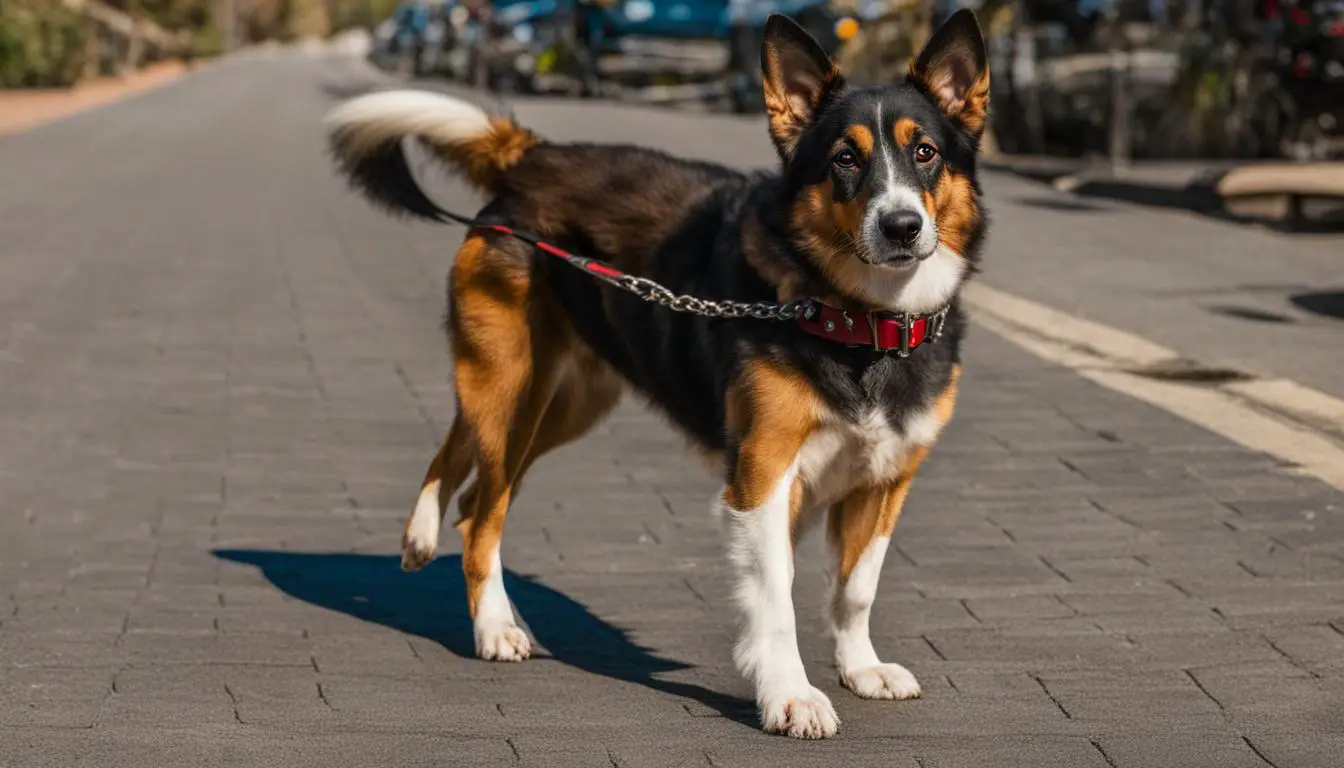How Tight Should a Dog Collar Be? Finding the Right Fit
According to the American Pet Products Association, 69 million American families own at least one dog. Knowing how tight a dog collar should be is essential for the safety and comfort of your furry friend.
A too-loose collar can result in your dog slipping out and getting lost, while a too-tight collar can cause discomfort, chafing, and even difficulty breathing. Finding the right fit for your dog’s specific needs is essential.
Risks of a Dog Collar Being Too Loose or Too Tight
An improperly fitted dog collar can pose risks to your furry friend’s safety and well-being. Whether the collar is too loose or tight, it can lead to various issues detrimental to your dog’s comfort and health.
When a dog collar is too loose, there is a risk of your dog slipping out of it and getting lost. This is especially concerning if you’re in an open or unfamiliar area. Additionally, a loose collar can also result in the collar getting caught on objects, potentially causing injury to your pet.
On the other hand, a too-tight collar can cause discomfort, chafing, and even difficulty breathing for your dog. It can lead to skin irritation and sores, making your dog restless and unhappy. In severe cases, a tight collar can restrict blood flow and even lead to injury or suffocation.
Risks of Loose and Tight Dog Collars
| Risks of Loose Dog Collar | Risks of Tight Dog Collar |
|---|---|
|
|
The Two-Finger Rule for Dog Collar Tightness
To ensure the safety and comfort of your furry friend, it’s essential to find the right fit for their dog collar. One commonly recommended method for determining the appropriate tightness is the two-finger rule.
This simple technique involves placing two fingers between your dog’s neck and the collar while lightly pulling back on it. The collar is likely a good fit if you can comfortably fit two fingers. This rule allows enough room for comfort and mobility while ensuring the collar is not too tight.
Measuring dog collar tightness using the two-finger rule is a quick and easy way to ensure a proper fit for your dog.
Remember, every dog is different, so it’s crucial to consider factors such as age, coat type, and activity level when determining the right fit for their collar.
Puppies may require more frequent adjustments as they grow, while adult dogs may need occasional collar tightening as they age. Dogs with thick fur or a wider neck may benefit from collars with a wider range of adjustability.
Benefits of the Two-Finger Rule:
- Allows for comfort and mobility
- Prevents discomfort, chafing, and difficulty breathing
- Quick and easy to use
Other Important Considerations for Dog Collar Fit
While the two-finger rule is a helpful guideline for determining the tightness of a dog collar, there are other important factors to consider when ensuring the right fit for your furry friend.
Every dog is unique, and their age, coat type, and activity level can all affect collar fit and comfort. Here are some additional considerations to keep in mind:
Collar Size Chart:
Using a collar size chart can be valuable in selecting the suitable collar for your dog. Different brands may have slightly different sizing options, so it’s essential to refer to the specific size chart provided by the manufacturer.
Measure your dog’s neck circumference and compare it to the chart to determine the appropriate size. Remember to choose a collar that allows for adjustment within the size range to accommodate any changes in your dog’s weight or fur thickness.
Adjusting Collar for Growing Puppy:
Puppies grow quickly, so checking and adjusting their collar regularly as they outgrow them is essential. A collar that is too tight can cause discomfort and restrict their movement.
As a general rule, you should be able to fit two fingers between the collar and your puppy’s neck. If the collar becomes too tight, it’s time to move up to the next size.
Collar Fit for Dogs with Thick Fur:
Finding the right collar fit for dogs with thick fur can be a bit more challenging. Selecting a collar with a wide range of adjustability is essential to accommodate their fur thickness.
Look for collars with additional sizing options or an adjustable buckle that allows you to customize the fit. Regularly check the tightness of the collar and make any necessary adjustments to ensure your dog’s comfort.
How to Measure for a Dog Collar
Ensuring the perfect fit for your dog’s collar is crucial for their comfort and safety. To measure your dog’s neck accurately, follow these simple steps:
- Use a soft measuring tape or a piece of string to measure the circumference of your dog’s neck.
- Measure where you want the collar to fit, neither tight nor loose.
- Make sure the measuring tape or string is snug but not too tight.
- Take note of the measurement in inches or centimeters.
Once you have the measurement, you can use it as a guide when selecting the correct collar size for your dog. Choosing a collar that allows for some adjustability is essential to ensure a proper fit.
Size Chart for Dog Collars
| Neck Circumference (in inches) | Collar Size |
|---|---|
| 8-12 | Small |
| 12-16 | Medium |
| 16-20 | Large |
| 20-24 | X-Large |
“Properly measuring your dog’s neck for a collar ensures a comfortable fit and prevents any discomfort or potential injury. Take the time to measure accurately, and don’t rely solely on your dog’s weight or breed as an indicator of collar size.” – Dr. Sarah Johnson, Veterinarian
Different Types of Dog Collars
Fabric Dog Collars
Fabric dog collars are a popular choice for their versatility and wide range of designs. These collars are typically made from durable and comfortable nylon or polyester. They offer adjustability to ensure a proper fit for your dog.
Fabric collars are suitable for dogs of all sizes and are a great option to express your dog’s personality with unique patterns and colors.
Chain Dog Collars
Chain dog collars, also known as choke collars or slip collars, are commonly used for training purposes and for dogs that require more control.
These collars are made from metal links and tighten when pulled, providing a corrective response. Using chain collars responsibly and under professional guidance is essential to avoid causing harm or discomfort to your dog.
Leather Dog Collars
Leather dog collars are known for their durability, style, and comfort. They are often made from high-quality leather and offer a classic and timeless look.
Leather collars suit dogs’ sensitivities to synthetic materials and are ideal for everyday wear and special occasions. They come in various designs, from simple to understated, elaborate, and embellished.
Lighted Dog Collars
Lighted dog collars are designed with built-in LED lights, making them perfect for nighttime walks or activities in low-light conditions.
These collars enhance visibility and safety, ensuring that your dog can be seen by passing vehicles and other pedestrians. Lighted collars often feature different lighting modes and can be a great addition to your dog’s outdoor gear.
Martingale Dog Collars
Martingale collars, or limited-slip collars, are designed to prevent dogs from slipping out of their collars.
These collars feature a loop design that tightens when your dog pulls, providing a gentle but effective correction. Martingale collars benefit dogs with narrow heads or those who tend to escape regular collars.
Electronic Dog Collars
Electronic dog collars, e-collars, or shock collars are used for training. These collars deliver mild electrical stimulation to get your dog’s attention and reinforce commands.
It’s important to note that electronic collars should be used responsibly and under professional guidance to ensure the safety and well-being of your dog.
Finding a Dog Collar That Ensures Safety and Security
Here are some essential tips to consider when choosing a suitable dog collar and ensuring safety for your furry friend:
Choosing the Right Dog Collar
When selecting a dog collar, you must consider your dog’s neck size, fur thickness, and activity level. The collar should be neither tight nor loose, striking the right balance for comfort and security.
A too-tight collar can cause discomfort, chafing, and difficulty breathing, while a too-loose collar may result in your dog quickly slipping out and getting lost.
Using the two-finger rule as a general guideline for collar tightness is recommended. Place two fingers between your dog’s neck and the collar while lightly pulling back.
The collar is likely a good fit if you can comfortably fit two fingers. Regularly check the collar’s fit and make necessary adjustments as your dog grows or changes in size.
Dog Collar Safety Tips
In addition to finding the right fit, there are some essential safety tips to keep in mind when using a dog collar:
- Ensure the collar is securely fastened but not too tight to restrict your dog’s breathing or movement.
- Regularly check the collar for any signs of wear and tear, such as fraying or looseness, and replace it if necessary.
- Add identification tags or a personalized dog ID tag to the collar for easy identification in case your dog gets lost.
- Consider using a breakaway collar for cats or adventurous dogs to prevent accidental choking if the collar gets caught on something.
The Benefits and Limitations of Dog Harnesses
A dog harness can be a choice to a traditional collar for walking and controlling your dog. While collars are commonly used, harnesses offer several advantages and disadvantages.
Advantages of Dog Harnesses
- Improved Comfort: Unlike collars, which put pressure on the neck, a harness distributes the force evenly across the dog’s body. This can be particularly beneficial for dogs prone to neck injuries or respiratory issues.
- Greater Control: Harnesses provide more control over your dog’s movement, especially if they tend to pull or lunge. The design allows you to steer your dog from the chest or back, making walks more manageable and safer.
- Reduced Choking Risk: When a dog pulls on a collar, it can cause choking, gagging, or difficulty breathing. A harness eliminates this risk by redirecting the pressure to the body, preventing potential harm to the dog’s throat and trachea.
Disadvantages of Dog Harnesses
- Expense: Quality harnesses can be more expensive than collars. However, investing in a durable and well-fitting harness can provide long-term benefits and comfort for your dog.
- Adjustment Period: Some dogs may require time to adjust to wearing a harness. Introducing the harness gradually is essential, using positive reinforcement to associate it with pleasant experiences.
- Freedom of Movement: While a harness provides more freedom of movement for your dog, it can also make them more challenging to control in certain situations, such as when encountering distractions or other animals. Additional training and proper handling may be necessary to ensure safety.
When deciding between a dog harness and a collar, consider your dog’s specific needs, size, behavior, and any existing health conditions. Choosing a harness that fits well, is adjustable, and is made with high-quality materials is essential. Consulting with a professional dog trainer or veterinarian can guide you in selecting the right option for your dog’s safety, comfort, and overall well-being.
Where to Find the Perfect Dog Collar
When finding the perfect dog collar for your furry friend, choosing a trusted brand that prioritizes quality and safety is essential. One such brand is Auburn Leathercrafters, a family-owned and operated company crafting high-quality dog collars and accessories since 1950.
Auburn Leathercrafters offers a wide range of handmade collars and leashes, ensuring you’ll find the perfect fit for your dog. Their collars are not only stylish but also durable, guaranteeing long-lasting use. With their attention to detail and commitment to excellence, Auburn Leathercrafters has earned the trust of countless dog owners.
When you choose Auburn Leathercrafters, you can have peace of mind knowing that you’re purchasing from a reputable brand that puts the well-being of your dog first. Their collars are made with comfort and safety in mind, providing the perfect balance between style and functionality.
To explore the selection of dog collars from Auburn Leathercrafters, visit their website or contact them directly. Their knowledgeable team will be more than happy to assist you in finding the best collar that suits your dog’s specific needs. Don’t settle for anything less than the best for your beloved pet.
FAQ
How tight should a dog collar be?
The collar should be snug enough to fit two fingers comfortably between your dog’s neck and the collar.
What are the risks of a dog collar being too loose or tight?
A loose collar can lead to your dog slipping out and getting lost, while a tight collar can cause discomfort, chafing, and difficulty breathing.
What is the two-finger rule for dog collar tightness?
The two-finger rule involves placing two fingers between your dog’s neck and the collar while lightly pulling back on it. The collar is likely a good fit if you can fit two fingers comfortably.
What other considerations are essential for dog collar fit?
Age, coat type, and activity level should be considered when determining the right fit for a dog’s collar. Puppies may require frequent adjustments as they grow, and dogs with thick fur or wider necks may benefit from collars with a wide range of adjustability.
How do I measure for a dog collar?
You can use a soft measuring tape or a piece of string to measure the circumference of your dog’s neck where you want the collar to fit. This will provide a more accurate measurement for selecting the correct collar size.
What are the different types of dog collars available?
There are various types of dog collars, including fabric, chain, leather, lighted, martingale, and electronic collars. Each type has its benefits and considerations for fit.
How do I ensure safety and security with a dog collar?
Choosing a reputable brand that prioritizes quality and safety when selecting a dog collar is essential. Regularly check the fit to ensure it is not too tight or loose, and consider adding identification tags or a personalized dog ID tag for extra security.
What are the benefits and limitations of dog harnesses?
Dog harnesses distribute force more evenly across the dog’s body and can be more comfortable, especially for dogs prone to neck injuries. However, harnesses may be more expensive and take longer for dogs to get used to. They can also provide more freedom of movement, making control more challenging in certain situations.
Where can I find the perfect dog collar?
Auburn Leathercrafters is a family-owned brand producing high-quality dog collars since 1950. They offer a wide range of handmade, innovative collars and leashes. Visit their website or contact them directly for assistance in finding the best collar for your furry friend.






